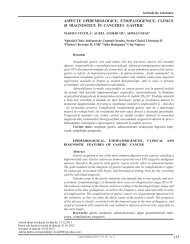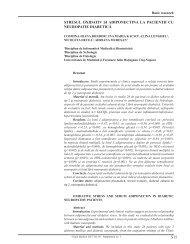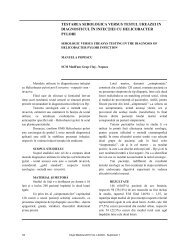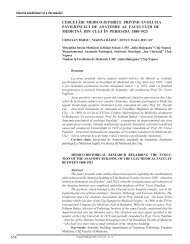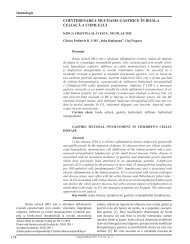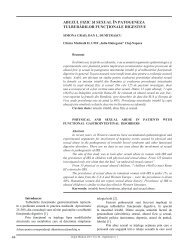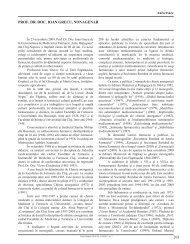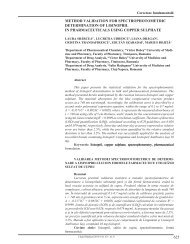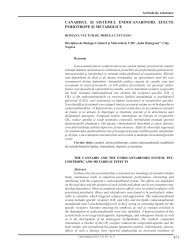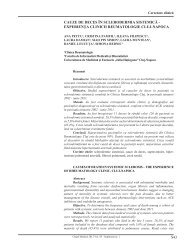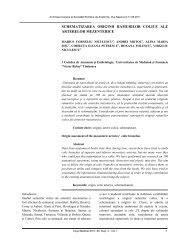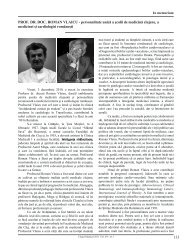- Page 1 and 2:
Clujul Medical Revistă de Medicin
- Page 3 and 4:
Articole de orientare Clujul Medica
- Page 5:
VOICHITA SĂBĂDUŞ, D. BORZEA, DIA
- Page 8 and 9:
CAMELIA GEORGETA RĂCĂREANU, GABRI
- Page 11 and 12:
Articole de orientare ROLUL NEUROKI
- Page 13 and 14:
Clujul Medical 2006 vol. LXXX - nr.
- Page 15 and 16:
Clujul Medical 2006 vol. LXXX - nr.
- Page 17 and 18:
DETECŢIA REARANJAMENTELOR SUBTELOM
- Page 19 and 20:
Clujul Medical 2006 vol. LXXX - nr.
- Page 21 and 22:
Clujul Medical 2006 vol. LXXX - nr.
- Page 23 and 24:
Clujul Medical 2006 vol. LXXX - nr.
- Page 25 and 26:
Clujul Medical 2006 vol. LXXX - nr.
- Page 27 and 28:
Clujul Medical 2006 vol. LXXX - nr.
- Page 29 and 30:
ACTUALITĂŢI ÎN PATOGENIA BOLII V
- Page 31 and 32:
Clujul Medical 2006 vol. LXXX - nr.
- Page 33 and 34:
Clujul Medical 2006 vol. LXXX - nr.
- Page 35 and 36:
Clujul Medical 2006 vol. LXXX - nr.
- Page 37 and 38:
Clujul Medical 2006 vol. LXXX - nr.
- Page 39 and 40:
Clujul Medical 2006 vol. LXXX - nr.
- Page 41 and 42:
Clujul Medical 2006 vol. LXXX - nr.
- Page 43 and 44:
Clujul Medical 2006 vol. LXXX - nr.
- Page 45 and 46:
Clujul Medical 2006 vol. LXXX - nr.
- Page 47 and 48:
Cercetare clinică EARLY COURSE OF
- Page 49 and 50:
Clujul Medical 2006 vol. LXXX - nr.
- Page 51 and 52:
Clujul Medical 2006 vol. LXXX - nr.
- Page 53 and 54:
Clujul Medical 2006 vol. LXXX - nr.
- Page 55 and 56:
Clujul Medical 2006 vol. LXXX - nr.
- Page 57 and 58:
Clujul Medical 2006 vol. LXXX - nr.
- Page 59 and 60:
Clujul Medical 2006 vol. LXXX - nr.
- Page 61 and 62:
Clujul Medical 2006 vol. LXXX - nr.
- Page 63 and 64:
Clujul Medical 2006 vol. LXXX - nr.
- Page 65 and 66:
Clujul Medical 2006 vol. LXXX - nr.
- Page 67 and 68:
Clujul Medical 2006 vol. LXXX - nr.
- Page 69 and 70:
Clujul Medical 2006 vol. LXXX - nr.
- Page 71 and 72:
Clujul Medical 2006 vol. LXXX - nr.
- Page 73 and 74:
Clujul Medical 2006 vol. LXXX - nr.
- Page 75 and 76:
Clujul Medical 2006 vol. LXXX - nr.
- Page 77 and 78:
Clujul Medical 2006 vol. LXXX - nr.
- Page 79 and 80:
APORTUL BIOPSIEI HISTOLOGICE ECOGHI
- Page 81 and 82:
Clujul Medical 2006 vol. LXXX - nr.
- Page 83 and 84:
Clujul Medical 2006 vol. LXXX - nr.
- Page 85 and 86:
Clujul Medical 2006 vol. LXXX - nr.
- Page 87 and 88:
Clujul Medical 2006 vol. LXXX - nr.
- Page 89 and 90:
Clujul Medical 2006 vol. LXXX - nr.
- Page 91 and 92:
Clujul Medical 2006 vol. LXXX - nr.
- Page 93 and 94:
Clujul Medical 2006 vol. LXXX - nr.
- Page 95 and 96:
Clujul Medical 2006 vol. LXXX - nr.
- Page 97 and 98:
Clujul Medical 2006 vol. LXXX - nr.
- Page 99 and 100:
Clujul Medical 2006 vol. LXXX - nr.
- Page 101 and 102:
Clujul Medical 2006 vol. LXXX - nr.
- Page 103 and 104:
ASOCIEREA TULBURĂRILOR DIGESTIVE F
- Page 105 and 106:
Clujul Medical 2006 vol. LXXX - nr.
- Page 107 and 108:
Clujul Medical 2006 vol. LXXX - nr.
- Page 109 and 110:
NEUTROPENII ASOCIATE CU ANEMII APLA
- Page 111 and 112:
Clujul Medical 2006 vol. LXXX - nr.
- Page 113 and 114:
Clujul Medical 2006 vol. LXXX - nr.
- Page 115 and 116:
Clujul Medical 2006 vol. LXXX - nr.
- Page 117 and 118:
Clujul Medical 2006 vol. LXXX - nr.
- Page 119 and 120:
Clujul Medical 2006 vol. LXXX - nr.
- Page 121 and 122:
Clujul Medical 2006 vol. LXXX - nr.
- Page 123 and 124:
Clujul Medical 2006 vol. LXXX - nr.
- Page 125 and 126:
ANTIALLERGIC ACTIVITY OF SUBSTITUTE
- Page 127 and 128:
Clujul Medical 2006 vol. LXXX - nr.
- Page 129 and 130:
Clujul Medical 2006 vol. LXXX - nr.
- Page 131 and 132:
Clujul Medical 2006 vol. LXXX - nr.
- Page 133 and 134:
Cazuri clinice ACUTE MEGAKARYOCYTIC
- Page 135 and 136:
Clujul Medical 2006 vol. LXXX - nr.
- Page 137 and 138:
POLYSEROSITIS AND MULTISYSTEMIC DYS
- Page 139 and 140:
Clujul Medical 2006 vol. LXXX - nr.
- Page 141 and 142: Clujul Medical 2006 vol. LXXX - nr.
- Page 143 and 144: Medicină dentară ASPECTE MORFOPAT
- Page 145 and 146: Clujul Medical 2006 vol. LXXX - nr.
- Page 147 and 148: Clujul Medical 2006 vol. LXXX - nr.
- Page 149 and 150: Clujul Medical 2006 vol. LXXX - nr.
- Page 151 and 152: Clujul Medical 2006 vol. LXXX - nr.
- Page 153 and 154: Clujul Medical 2006 vol. LXXX - nr.
- Page 155 and 156: Clujul Medical 2006 vol. LXXX - nr.
- Page 157 and 158: PARTICULARITĂŢI ÎN CONCEPEREA PR
- Page 159 and 160: Clujul Medical 2006 vol. LXXX - nr.
- Page 161 and 162: Clujul Medical 2006 vol. LXXX - nr.
- Page 163 and 164: CITOKINE PROINFLAMATORII ÎN BOALA
- Page 165 and 166: Clujul Medical 2006 vol. LXXX - nr.
- Page 167 and 168: Clujul Medical 2006 vol. LXXX - nr.
- Page 169 and 170: CONTRIBUŢII LA AMPRENTELE FONETICE
- Page 171 and 172: Clujul Medical 2006 vol. LXXX - nr.
- Page 173 and 174: Clujul Medical 2006 vol. LXXX - nr.
- Page 175 and 176: Clujul Medical 2006 vol. LXXX - nr.
- Page 177 and 178: Clujul Medical 2006 vol. LXXX - nr.
- Page 179 and 180: Clujul Medical 2006 vol. LXXX - nr.
- Page 181 and 182: Farmacie STUDII ASUPRA STRUCTURII M
- Page 183 and 184: Clujul Medical 2006 vol. LXXX - nr.
- Page 185 and 186: Clujul Medical 2006 vol. LXXX - nr.
- Page 187 and 188: Clujul Medical 2006 vol. LXXX - nr.
- Page 189 and 190: Clujul Medical 2006 vol. LXXX - nr.
- Page 191: Clujul Medical 2006 vol. LXXX - nr.
- Page 195 and 196: STUDIU PRIVIND ACHIZIŢIA MEDICAMEN
- Page 197 and 198: Nr. crt. Clujul Medical 2006 vol. L
- Page 199 and 200: Clujul Medical 2006 vol. LXXX - nr.
- Page 201 and 202: Clujul Medical 2006 vol. LXXX - nr.
- Page 203 and 204: CERCETĂRI PRELIMINARE ASUPRA COMPU
- Page 205 and 206: Clujul Medical 2006 vol. LXXX - nr.
- Page 207 and 208: Clujul Medical 2006 vol. LXXX - nr.
- Page 209 and 210: Idei în medicină CERCETAREA ŞTII
- Page 211 and 212: Clujul Medical 2006 vol. LXXX - nr.



